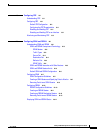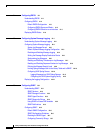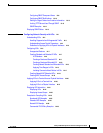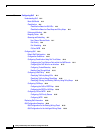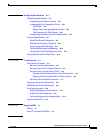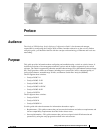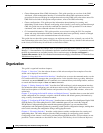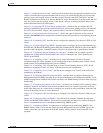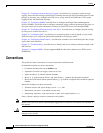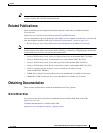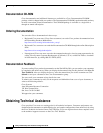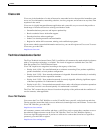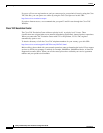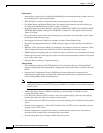
xxv
Catalyst 2950 Desktop Switch Software Configuration Guide
78-11380-05
Preface
Organization
Chapter 7, “Administering the Switch,” describes how to perform one-time operations to administer your
switch. It describes how to prevent unauthorized access to your switch through the use of passwords,
privilege levels, the Terminal Access Controller Access Control System Plus (TACACS+), and the
Remote Authentication Dial-In User Service (RADIUS). It also describes how to set the system date and
time, set system name and prompt, create a login banner, and how to manage the MAC address and
Address Resolution Protocol (ARP) tables.
Chapter 8, “Configuring 802.1X Port-Based Authentication,” describes how to configure 802.1X
port-based authentication to prevent unauthorized devices (clients) from gaining access to the network.
As LANs extend to hotels, airports, and corporate lobbies, insecure environments could be created.
Chapter 9, “Configuring Interface Characteristics,” defines the types of interfaces on the switch. It
describes the interface global configuration command and provides procedures for configuring physical
interfaces.
Chapter 10, “Configuring STP,” describes how to configure the Spanning Tree Protocol (STP) on your
switch.
Chapter 11, “Configuring RSTP and MSTP,” describes how to configure the Cisco implementation of
the IEEE 802.1W Rapid STP (RSTP) and the IEEE 802.1S Multiple STP (MSTP) on your switch. RSTP
provides rapid convergence, and MSTP enables VLANs to be grouped into a spanning-tree instance.
Chapter 12, “Configuring Optional Spanning-Tree Features,” describes how to configure optional
spanning-tree features that can be used when your switch is running the per-VLAN spanning-tree
(PVST) or the MSTP.
Chapter 13, “Configuring VLANs,” describes how to create and maintain VLANs. It includes
information about the VLAN database, VLAN configuration modes, extended-range VLANs, VLAN
trunks, and the VLAN Membership Policy Server (VMPS).
Chapter 14, “Configuring VTP,” describes how to use the VLAN Trunking Protocol (VTP) VLAN
database for managing VLANs. It includes VTP characteristics and configuration.
Chapter 15, “Configuring Voice VLAN,” describes how to configure voice VLANs on the switch for a
connection to an IP phone.
Chapter 16, “Configuring IGMP Snooping and MVR,” describes how to configure Internet Group
Management Protocol (IGMP) snooping. It also describes Multicast VLAN Registration (MVR), a local
IGMP snooping feature available on the switch, and how to use IGMP filtering to control multicast group
membership.
Chapter 17, “Configuring Port-Based Traffic Control,” describes how to reduce traffic storms by setting
broadcast, multicast, and unicast storm-control threshold levels; how to protect ports from receiving
traffic from other ports on a switch; how to configure port security by using secure MAC addresses; and
how to set the aging time for all secure addresses.
Chapter 19, “Configuring CDP,” describes how to configure Cisco Discovery Protocol (CDP) on your
switch.
Chapter 20, “Configuring SPAN and RSPAN,” describes how to configure Switched Port Analyzer
(SPAN) and Remote SPAN (RSPAN), which select network traffic for analysis by a network analyzer
such as a SwitchProbe device or other Remote Monitoring (RMON) probe.
Chapter 21, “Configuring RMON,” describes how to configure remote monitoring (RMON). The
RMON feature, which is used with the Simple Network Management Protocol (SNMP) agent in the
switch, means that you can monitor all the traffic flowing among switches on all connected LAN
segments.



